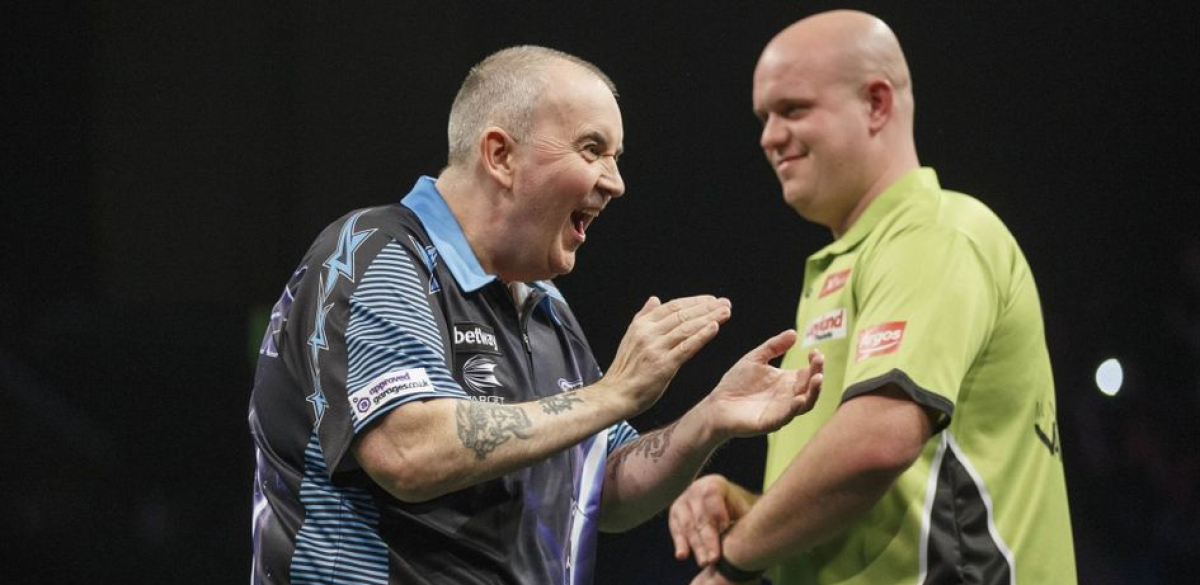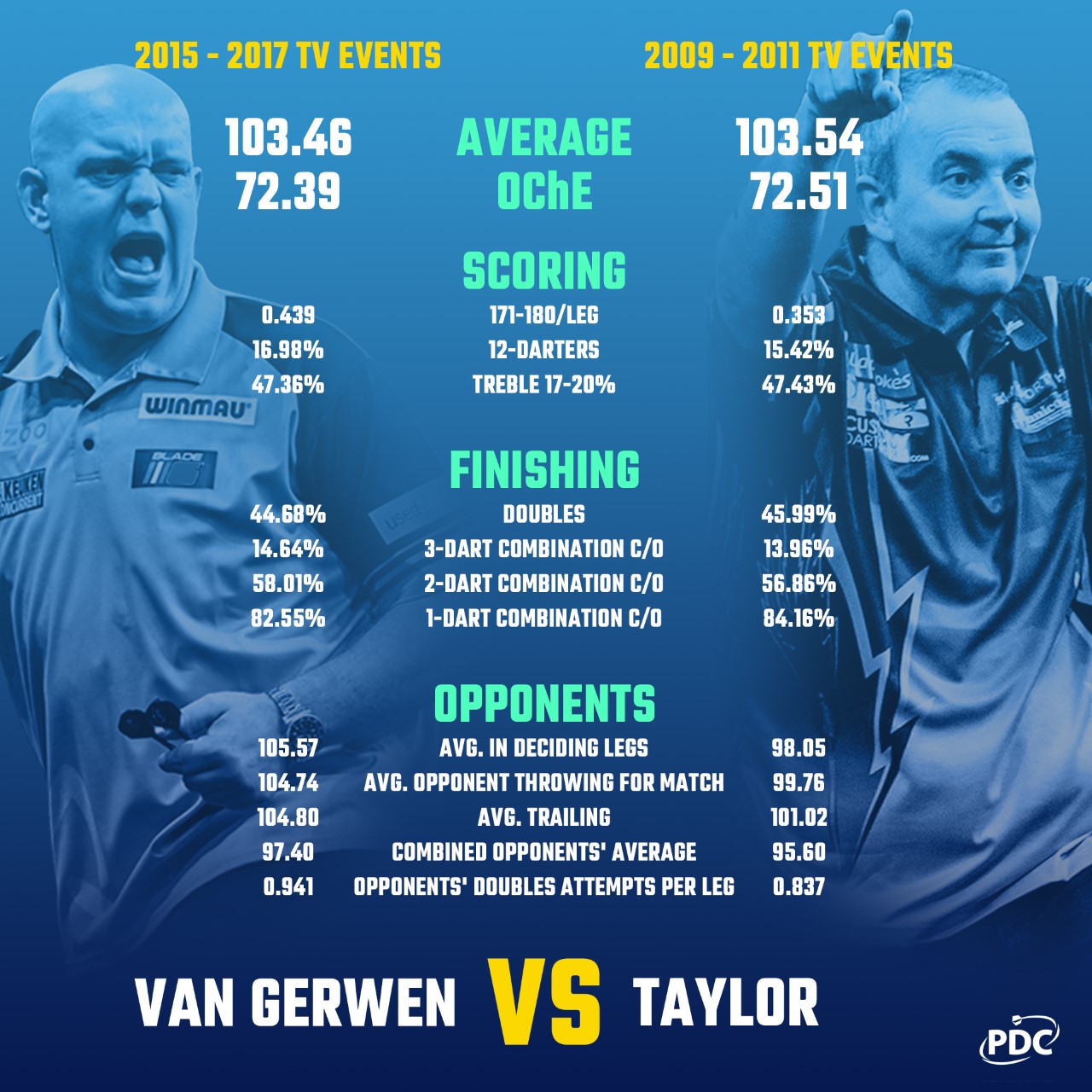
PDC stats analyst Christopher Kempf analyses arguably the sport’s two greatest players – Phil Taylor and Michael van Gerwen – with a look at how their statistics compare for the most prolific periods of their careers.

The comparative all-time greatness, quality or achievements of Phil Taylor and Michael van Gerwen will never cease to provoke disagreement among darts fans, and when this question is debated, the greatness of the two players is inevitably measured in different ways.
Taylor is a 16-time World Champion, and even Van Gerwen admits that is an achievement which will never be surpassed - thus he is the greatest.
Van Gerwen has achieved similar dominance to Taylor's against tougher opponents and broke many of Taylor's records before turning 30; thus he is the greatest.
Taylor has won professional titles in four different decades; Van Gerwen has shown the most obvious talent for the game of any professional since his teenage years.
Because the standards of excellence for Taylor and Van Gerwen are often so different, and because of the generational gap between the two, it's tempting to consider the following question: Which player was the more formidable competitor 'in their prime'?
The selection of any run of years as a player's 'prime' is arbitrary and ambiguous - how long did it last? What caused it to begin or end? And even, in Van Gerwen’s case, if he has yet reached, or passed, his prime? However, in order to attempt to analyse this question, we will have to accept this objection.
For Taylor, the 2009-2011 period encompasses the highest average ever in a World Championship final [against Raymond van Barneveld in 2009], and his two nine-dart legs in a single match at the 2010 Premier League.
This also includes an unparalleled run of dominance at the World Matchplay, in which Taylor won 72% of legs he contested.
For Van Gerwen, the 2015-2017 period takes in his world record average of 123.40 at the 2016 Premier League, and the highest-standard World Championship match of all time between himself and Raymond van Barneveld.
Furthermore, this includes the period in the winter of 2017 in which the Dutchman held every televised ranking title on offer.
The PDC calendar of 2010 differed substantially from that of 2016, making direct comparisons between the overall play of Taylor and Van Gerwen at these respective zeniths impossible.
The advent of the European Tour and the World Series has created numerous opportunities for top players to boost their income in stage events that did not exist for players at the beginning of the decade.
To take advantage of the data that does exist for the two titans in the most high-profile events, we will consider only performances on TV between the 2009 and 2012 World Championships for Taylor, and between the 2015 & 2018 World Championships for Van Gerwen.
If we consider points scored and darts thrown and nothing more, the result is basically a draw: a 103.54 average for Taylor versus a 103.46 average for Van Gerwen.
Additionally, 9% of Van Gerwen's match averages and 8% of Taylor's exceeded 110, but the latter was the more likely to average 100+ in a match lasting 20 or more legs.
There is similarly little to separate the treble accuracy rates of the two players - even the renowned Van Gerwen treble 19 accuracy of 47.7% is only 0.6 points ahead of Taylor's.
The differences between the two players make themselves known when it comes to finishing. Taylor 'in his prime' was more accurate overall in attempting doubles - 46.0% vs Van Gerwen’s 44.7%.
But this could just mean that Taylor is more likely to have completed 40 checkouts in one dart than in three, which would make no difference to the outcome of the match.
Indeed, we find that while Taylor was the better finisher with three clear darts at a double, Van Gerwen completed more of his two-and three-dart combination shots.
One clear advantage possessed by Van Gerwen is his much higher rate of scoring maxima (171-180) - his rate in 2015-2017 is nearly 25% higher than that of Phil Taylor.
This also translated into a higher rate of 10, 11 and 12-darters - 17.0% of eligible legs for Van Gerwen, and only 15.4% for Taylor.
However, the fact that Taylor pulls ahead when it comes to 13, 14 and 15-darters suggests that he was the more consistent performer, wearing out his opponents with his relentless nature.
Van Gerwen, meanwhile - the more aggressive and intuitive player - was more likely to be utterly unplayable in patches.
Taylor lost so few matches from 2009 to 2011 that it is almost impossible to generate meaningful statistics for his performance under pressure, or with an opponent on the brink of victory.
One measure of his greatness is certainly that he put himself in such situations so seldom. But the question remains, if Taylor faced more difficult opponents more regularly, would he have risen to the challenge?
In the few televised deciding legs that Taylor played, his average was only 98 – over five points less than his average in all other legs. Similarly, with his opponents throwing for the match, his average was also less than 100.
In contrast, the Dutchman, who faced these situations much more frequently than Taylor, improved on his averages by 1.3 points when facing an opponent throwing for the match, and 2.1 points in a decider.
We know that Van Gerwen's 'prime' TV opponents won more legs and averaged 1.8 points more than Phil Taylor's, even though Taylor's attempted fewer doubles per leg, which should have had the effect of bringing their averages up.
Yet that doesn't tell us anything about how 2010 Taylor would have played against 2016 opponents, or how 2016 Van Gerwen would have played against 2010 opponents.
Perhaps the fairest comparison we can make between these two darting legends is to evaluate their performances against the standard of the 2022 Pro Tour.
Using the Ordinal Checkout Efficiency (OChE) statistic, we can use the checkout rate of both players in the fourth, fifth, sixth and seventh visits and measure the weighted average against that of contemporary Tour Card Holders.
The result is astonishing - Phil Taylor's TV performances more than a decade ago would still win him 72.5% of legs on the 2022 Pro Tour.
For Van Gerwen that percentage is 72.4% - meaning that Taylor's performances would win him only one more than the Dutchman out of a thousand legs played.
Is that enough to declare 'prime Taylor' the winner over 'prime Van Gerwen'?
Perhaps if these two hypothetical players had played a 1000 leg match and Taylor had triumphed, we could say so - but for an indirect comparison, we can only say that the difference between them in OChE is statistically insignificant - too close to call.
When Van Gerwen and Taylor did play regularly during the Dutchman’s prime, Van Gerwen emerged the clear favourite, winning 15 out of 24 matches and drawing once.
Had Van Gerwen been born six years earlier - or Taylor six years later such that their prime years coincided - we could have witnessed a rivalry of an unprecedented standard, certainly by any past match-up and possibly by any to come in the future.
Follow Christopher Kempf on Twitter via @Ochepedia.